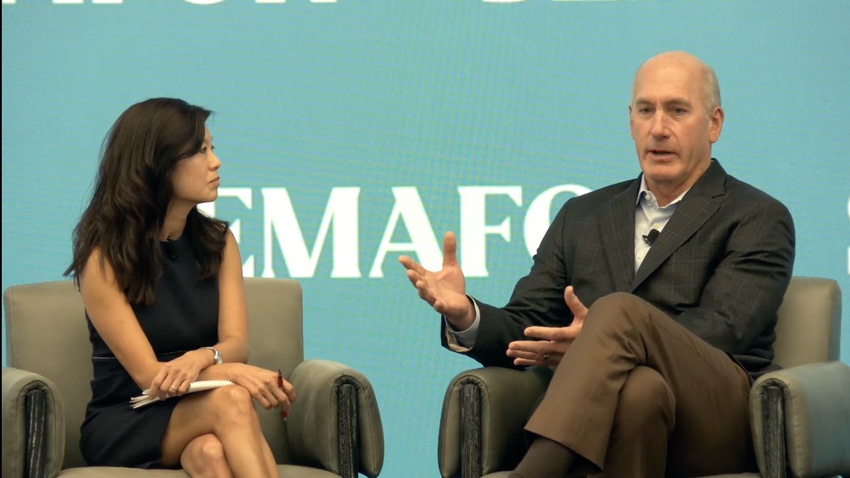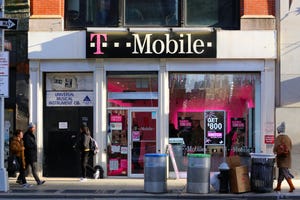AT&T jumps on better-than-expected Q3 results, improved guidance
AT&T added 468,000 new postpaid phone customers to its 5G network, alongside 296,000 new fiber customers. And it raised its 2023 free cash flow guidance to about $16.5 billion, versus its prior guidance of $16 billion or better.

AT&T reported financials in the third quarter that were largely ahead of what financial analysts had expected, a development that sent the company's shares popping in early trading.
"The fundamentals of our business have never been stronger," boasted AT&T CEO John Stankey during the company's quarterly conference call Thursday.
AT&T's stock gained almost $1 per share immediately after the release of the company's report, rising from roughly $14 to $15 per share.
"We believe AT&T's earnings are likely to be positive to the stock today as results were mostly above expectations," wrote the financial analysts at KeyBanc Capital Markets in a note to investors immediately after the release of AT&T's results. "Total revenue and adjusted EBITDA [earnings before interest, taxes, depreciation and amortization] beat consensus estimates, driven by better than expected EBITDA in Mobility and Consumer Wireline offset by lower Business Wireline."
Others agreed. "AT&T posted healthy 3Q23 results," wrote the financial analysts at Evercore in their own note to investors.
AT&T, for its part, increased its overall financial guidance for the remainder of the year. The company said it now expects full-year 2023 free cash flow of about $16.5 billion, versus its prior guidance of $16 billion or better.
"I could not be happier," AT&T CFO Pascal Desroches said during the company's earnings call.
The results are noteworthy considering ongoing fears that cable companies like Comcast and Charter Communications will suck all the growth out of a decelerating US wireless industry. There also remain concerns that AT&T's fiber business will suffer amid increasing competition among cable and fiber competitors that are all working to expand their reach.
The mobility stuff
In its 5G business, AT&T reported postpaid phone net customer additions of 468,000, ahead of most analyst estimates and notably better than the 326,000 the company reported in its previous quarter. The company's churn – the number of AT&T customers disconnecting service – was also "particularly low" at 0.79%, according to the analysts at Evercore.
AT&T ended the quarter covering 190 million people with its speedy midband 5G network, and said it remains on track to cover 200 million by the end of the year. That would put the company slightly behind Verizon's plan to cover 250 million people by the end of the year with its own midband 5G network, and T-Mobile's plan to cover 300 million by that time.
"We continue to feel really good about the performance of our wireless business," AT&T's CFO, Desroches, said.
And Stankey took direct aim at concerns that cable companies like Comcast and Charter would cut into AT&T's wireless business. "I think I'm OK with what's going on," he said. "I don't see that changing right now."
He also said those cable companies are basing their mobility business on Verizon's network, via MVNOs with the company, which won't give them owner's economics. "I don't think it's a sustainable strategy," he said.
The fiber stuff
AT&T added 296,000 new fiber customers to its network, above most analyst expectations. And the company lost 281,000 non-fiber IP broadband customers and 23,000 DSL customers, figures also better than expected.
AT&T said it gained 25,000 fixed wireless customers.
The overall result was that AT&T lost a total of 8,000 fixed Internet customers, which was better than most expectations and also an improvement over the 54,000 total fixed Internet customers it lost in the previous quarter.
AT&T said it currently covers 24 million locations with fiber, a figure it said it will expand to 30 million by 2025.
"Our AT&T Internet Air product is off to a solid start," said Desroches. AT&T recently joined T-Mobile and Verizon in selling fixed wireless access (FWA) services over its midband 5G network. It's doing so under the Internet Air brand.
"Nothing has changed with our approach to Internet Air," Stankey said, explaining the company plans to offer the service both inside and outside its wireline footprint on a "careful and surgical basis."
Stankey also addressed questions about the US government's $42.45 billion Broadband Equity Access and Deployment (BEAD) program, which is designed to funnel cash to Internet providers like AT&T to help them build networks in rural areas. Stankey said AT&T would participate in the program, but that it doesn't expect to score revenues from BEAD customers until 2025.
The CEO also said AT&T's fiber strategy is beginning to mature, in that the company is employing a different marketing strategy in locations where it surpasses a 40% market share. "Our tactics do switch" in those locations, he said, explaining that the company focuses on bundling and different marketing channels in those more mature markets.
"That's why you see that business scaling so nicely," said Stankey.
Net neutrality, convergence and the future
As many other telecom executives have done, Stankey spoke out against the FCC's new net neutrality push. "No customers are complaining … so why we would use taxpayer money and resources and political capital to chase a problem that doesn't exist is a bit of a mystery to me."
Stankey added that legislators and regulators ought to focus on other telecom problems including spectrum policy and Universal Service Fund management.
The topic is timely considering the FCC on Thursday is scheduled to vote to begin its procedure into net neutrality. "In the wake of the pandemic, we know that broadband is a necessity, not a luxury. That's why we made a historic commitment to connecting all of us to broadband. Now we have work to do to make sure that it's fast, open and fair," explained FCC Chairwoman Jessica Rosenworcel during her agency's meeting. She said the FCC's efforts are intended to position the agency to protect consumers in other areas including privacy and cybersecurity.
Interestingly, Stankey also discussed the topic of network convergence, arguing AT&T is the company that is best positioned to profit from the intersection of fiber and 5G considering it's actively building out both network technologies.
"AT&T customers with [bundled] fiber and wireless service have our lowest churn and highest lifetime values to match," he said. "We're positioned to do this with the lowest unit economic cost, establishing a long runway for sustainable returns."
Finally, Stankey addressed a question about AT&T's future network spending. That's a hot topic given the widespread doom and gloom among telecom vendors in the US and across the world. Indeed, Nokia on Thursday said it would cut up to 14,000 jobs to counter sales slowdowns in North America and elsewhere.
Stankey said AT&T isn't changing its overall capital expense (capex) guidance for 2023, implying the company will raise spending in the final months of the year. But he said the company is positioning itself to slow spending overall in the future after investing heavily in 5G in 2022 and 2023.
Stankey also said that AT&T would look to smooth out its capex spending so it's more consistent from one quarter to the next.
About the Author(s)
You May Also Like












